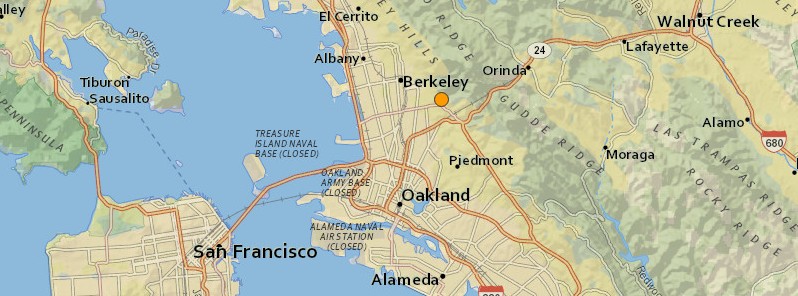Sharp M4.7 earthquake followed by 5 – 10 seconds of shaking hits San Francisco, California

A sharp M4.7 earthquake hit 3 km (1.9 miles) ESE of Berkley, California at 10:39 UTC (02:39 PST) on January 4, 2017, according to the USGS. The quake hit at a depth of 13 km (8 miles) and was felt for about 5 – 10 seconds as far away as Marin and Sonoma counties as well as Silicon Valley.
The epicenter was centered between Berkley and Oakland, on the Hayward Fault Zone.
Although this quake is not expected to cause major damage, there is always a possibility of some minor damage to older structures, the USGS said.
The Hayward Fault Zone is about 119 km (74 miles) long, situated mainly along the western base of the hills on the east side of San Francisco Bay. It runs through densely populated areas, including Richmond, El Cerrito, Berkeley, Oakland, San Leandro, Hayward, Union City, Fremont, and San Jose. It is one of the most feared ones in the Bay Area, capable of producing a magnitude 7 or greater earthquakes directly under heavily populated areas.
On average, this fault produces a large earthquake every 170 years, with a margin of error of about 80 years, and since it has been 149 years since the most recent major earthquake, today's event sparked fear it's a precursor to the big one.
Hayward Fault
The Hayward Fault is a mostly right-lateral, strike-slip fault with approximately 5 mm/yr (1/5 inch/year) of creep. The 2003 Working Group for California Earthquake Probability, in agreement with previous working groups going back to 1990, assigned a slip rate on the Hayward Fault to be about 9 mm/yr (1/3 inch/year). This implies that approximately 4 mm/yr of motion is taken up in a stick-slip fashion, leading to the generation of earthquakes.
The Hayward Fault runs from San Pablo Bay in the north to Fremont in the south, passing through the cities of Berkeley, Oakland, Hayward, and Fremont. South of Fremont the fault branches into a complex set of surface faults that connect the Hayward Fault to the central part of the Calaveras Fault. The Hayward and Calaveras Faults may have a simpler connection at depths more than 5 km (3 miles), joining in the subsurface just south of the Calaveras Reservoir (site of the October 30, 2007 M5.4 Alum Rock earthquake). The Hayward Fault may be segmented into a northern and southern segment in the vicinity of Berkeley or Oakland.
The most recent major earthquake on the Hayward Fault occurred at 7:53 AM on October 21, 1868 with an estimated magnitude of ??. With an epicenter in the heart of the Bay Area, then having the largest population on the west coast with a total of 260 000 residents, this earthquake was one of the most destructive in California history, and remains the nation's 12th most lethal earthquake. Property loss was extensive and 30 people were killed. Five deaths were reported in San Francisco, out of a population of 150 000, where the total property loss was estimated to be $350,000 (in 1868 dollars). This earthquake was known as the "great San Francisco earthquake" until the magnitude 7.9 shock on the San Andreas Fault on April 18, 1906.
Geologic studies at Tule Pond (Fremont) on the southern segment of the Hayward Fault have shown that the average interval between the past 5 earthquakes has been 140 ± 50 years. The average interval of the past 11 earthquakes on this segment of the fault is 170 ± 80 years.
The 2003 Working Group for California Earthquake Probability assigned a 27% probability that the Hayward-Rodgers Creek Fault system would produce a magnitude 6.7 or larger earthquake in the next 30 years. (USGS)
Featured image credit: USGS

Commenting rules and guidelines
We value the thoughts and opinions of our readers and welcome healthy discussions on our website. In order to maintain a respectful and positive community, we ask that all commenters follow these rules.